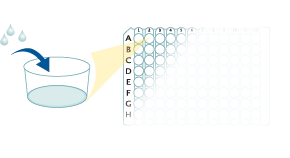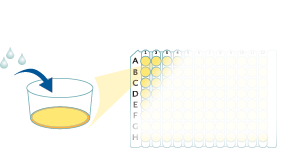Human KGF/FGF-7 Quantikine ELISA Kit Summary
Product Summary
Precision
Cell Culture Supernates
| Intra-Assay Precision | Inter-Assay Precision | |||||
|---|---|---|---|---|---|---|
| Sample | 1 | 2 | 3 | 1 | 2 | 3 |
| n | 20 | 20 | 20 | 40 | 40 | 40 |
| Mean (pg/mL) | 82.4 | 248 | 1031 | 86.5 | 266 | 1108 |
| Standard Deviation | 3.2 | 8.8 | 55.2 | 4.8 | 11.4 | 62 |
| CV% | 3.9 | 3.5 | 5.4 | 5.5 | 4.3 | 5.6 |
Serum, EDTA Plasma, Heparin Plasma, Citrate Plasma
| Intra-Assay Precision | Inter-Assay Precision | |||||
|---|---|---|---|---|---|---|
| Sample | 1 | 2 | 3 | 1 | 2 | 3 |
| n | 20 | 20 | 20 | 40 | 40 | 40 |
| Mean (pg/mL) | 97.9 | 298 | 1229 | 95.5 | 294 | 1221 |
| Standard Deviation | 3.3 | 8.8 | 42.8 | 7.4 | 15.6 | 63.5 |
| CV% | 3.4 | 3 | 3.5 | 7.7 | 5.3 | 5.2 |
Recovery
The recovery of KGF spiked to three different levels throughout the range of the assay in various matrices was evaluated.
| Sample Type | Average % Recovery | Range % |
|---|---|---|
| Cell Culture Media (n=5) | 102 | 95-105 |
| Citrate Plasma (n=5) | 91 | 86-98 |
| EDTA Plasma (n=5) | 96 | 85-104 |
| Heparin Plasma (n=5) | 90 | 85-99 |
| Serum (n=5) | 93 | 85-100 |
Linearity
Scientific Data
Product Datasheets
Preparation and Storage
Background: KGF/FGF-7
KGF (keratinocyte growth factor), also known as FGF-7, is induced in mesenchymal cells by inflammation or tissue damage. It functions as a paracrine factor during wound healing by inducing the proliferation of nearby epithelial cells. KGF plays a role in kidney morphogenesis, hair follicle development, and keratinocyte differentiation. It signals only through the IIIb splice form of the tyrosine kinase receptor, FGF R2 (IIIb)/KGF R.
Assay Procedure
Refer to the product- Prepare all reagents, standard dilutions, and samples as directed in the product insert.
- Remove excess microplate strips from the plate frame, return them to the foil pouch containing the desiccant pack, and reseal.
- Add 100 µL of Assay Diluent to each well.
- Add 100 µL of Standard, control, or sample to each well. Cover with a plate sealer, and incubate at room temperature for 3 hours.
- Aspirate each well and wash, repeating the process 3 times for a total of 4 washes.
- Add 200 µL of Conjugate to each well.
- For Serum & Plasma Samples: Cover with a new plate sealer, and incubate at room temperature for 2 hours.
For Cell Culture Supernate Samples: Cover with a new plate sealer, and incubate at room temperature for 1.75 hours. - Aspirate and wash 4 times.
- Add 200 µL Substrate Solution to each well. Incubate at room temperature for 30 minutes. PROTECT FROM LIGHT.
- Add 50 µL of Stop Solution to each well. Read at 450 nm within 30 minutes. Set wavelength correction to 540 nm or 570 nm.





Citations for Human KGF/FGF-7 Quantikine ELISA Kit
R&D Systems personnel manually curate a database that contains references using R&D Systems products. The data collected includes not only links to publications in PubMed, but also provides information about sample types, species, and experimental conditions.
15
Citations: Showing 1 - 10
Filter your results:
Filter by:
-
Tumor-Stromal Interactions in a Co-Culture Model of Human Pancreatic Adenocarcinoma Cells and Fibroblasts and Their Connection with Tumor Spread
Authors: E Prieto-Gar, CV Díaz-Garcí, A Agudo-Lópe, V Pardo-Marq, I García-Con, S Asensio-Pe, M Alonso-Ria, C Pérez, C Gómez, J Adeva, L Paz-Ares, JA López-Mart, MT Agulló-Ort
Biomedicines, 2021-03-31;9(4):.
Species: Human
Sample Types: Cell Culture Supernates
-
Ex Vivo Expansion of Human Limbal Epithelial Cells Using Human Placenta-Derived and Umbilical Cord-Derived Mesenchymal Stem Cells
Authors: SM Nam, YS Maeng, EK Kim, KY Seo, H Lew
Stem Cells Int, 2017-08-15;2017(0):4206187.
Species: Human
Sample Types: Cell Culture Supernates
-
Impact of Hyperglycemia and Low Oxygen Tension on Adipose-Derived Stem Cells Compared with Dermal Fibroblasts and Keratinocytes: Importance for Wound Healing in Type 2 Diabetes
PLoS ONE, 2016-12-19;11(12):e0168058.
Species: Human
Sample Types: Cell Culture Supernates
-
The role of HGF/MET and FGF/FGFR in fibroblast-derived growth stimulation and lapatinib-resistance of esophageal squamous cell carcinoma.
Authors: Saito S, Morishima K, Ui T, Hoshino H, Matsubara D, Ishikawa S, Aburatani H, Fukayama M, Hosoya Y, Sata N, Lefor A, Yasuda Y, Niki T
BMC Cancer, 2015-02-25;15(0):82.
Species: Human
Sample Types: Cell Culture Supernates
-
Prevention of radiation-induced oral mucositis after adenoviral vector-mediated transfer of the keratinocyte growth factor cDNA to mouse submandibular glands.
Authors: Zheng C, Cotrim AP, Sunshine AN, Sugito T, Liu L, Sowers A, Mitchell JB, Baum BJ
Clin. Cancer Res., 2009-07-07;15(14):4641-8.
Species: Mouse
Sample Types: Cell Culture Supernates
-
Mechanisms of renal phosphate loss in liver resection-associated hypophosphatemia.
Authors: Nafidi O, Lapointe RW, Lepage R, Kumar R, D'Amour P
Ann. Surg., 2009-05-01;249(5):824-7.
Species: Human
Sample Types: Serum
-
Keratinocyte growth factor expression is suppressed in early acute lung injury/acute respiratory distress syndrome by smad and c-Abl pathways.
Authors: Chandel NS, Budinger GR, Mutlu GM, Varga J, Synenki L, Donnelly HK, Zirk A, Eisenbart J, Jovanovic B, Jain M
Crit. Care Med., 2009-05-01;37(5):1678-84.
Species: Human
Sample Types: BALF
-
Tissue engineering for full-thickness burns: a dermal substitute from bench to bedside.
Authors: Kellouche S, Martin C, Korb G, Rezzonico R, Bouard D, Benbunan M, Dubertret L, Soler C, Legrand C, Dosquet C
Biochem. Biophys. Res. Commun., 2007-09-04;363(3):472-8.
Species: Human
Sample Types: Cell Culture Supernates
-
Selective cyclooxygenase-2 inhibitor downregulates the paracrine epithelial-mesenchymal interactions of growth in scirrhous gastric carcinoma.
Authors: Yashiro M, Nakazawa K, Tendo M, Kosaka K, Shinto O, Hirakawa K
Int. J. Cancer, 2007-02-01;120(3):686-93.
Species: Human
Sample Types: Cell Culture Supernates
-
Keratinocyte-fibroblast paracrine interaction: the effects of substrate and culture condition.
Authors: Witte RP, Kao WJ
Biomaterials, 2005-06-01;26(17):3673-82.
Species: Human
Sample Types: Whole Cells
-
Salivary leptin induces increased expression of growth factors in oral keratinocytes.
Authors: Groschl M, Topf HG, Kratzsch J, Dotsch J, Rascher W, Rauh M
J. Mol. Endocrinol., 2005-04-01;34(2):353-66.
Species: Human
Sample Types: Cell Culture Supernates
-
Increase in gap junctional intercellular communication by high molecular weight hyaluronic acid associated with fibroblast growth factor 2 and keratinocyte growth factor production in normal human dermal fibroblasts.
Authors: Park JU, Tsuchiya T
Tissue Eng., 2002-07-01;8(3):419-27.
Species: Human
Sample Types: Cell Culture Supernates
-
High concentrations of keratinocyte growth factor in airways of premature infants predicted absence of bronchopulmonary dysplasia.
Authors: Danan C, Franco ML, Jarreau PH, Dassieu G, Chailley-Heu B, Bourbon J, Delacourt C
Am. J. Respir. Crit. Care Med., 2002-05-15;165(10):1384-7.
Species: Human
Sample Types: Tracheal Lavage Fluid
-
Upregulation of keratinocyte growth factor in the tracheal ligation lamb model of congenital diaphragmatic hernia.
Authors: McCabe AJ, Carlino U, Holm BA, Glick PL
J. Pediatr. Surg., 2001-01-01;36(1):128-32.
Species: Ovine
Sample Types: Tissue Homogenates
-
c-Jun and JunB antagonistically control cytokine-regulated mesenchymal-epidermal interaction in skin.
Authors: Szabowski A, Maas-Szabowski N, Andrecht S, Kolbus A, Schorpp-Kistner M, Fusenig NE, Angel P
Cell, 2000-11-22;103(5):745-55.
Species: Human
Sample Types: Cell Culture Supernates
FAQs
No product specific FAQs exist for this product, however you may
View all ELISA FAQsReviews for Human KGF/FGF-7 Quantikine ELISA Kit
Average Rating: 4 (Based on 1 Review)
Have you used Human KGF/FGF-7 Quantikine ELISA Kit?
Submit a review and receive an Amazon gift card.
$25/€18/£15/$25CAN/¥75 Yuan/¥2500 Yen for a review with an image
$10/€7/£6/$10 CAD/¥70 Yuan/¥1110 Yen for a review without an image
Filter by:






